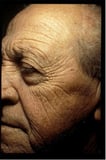How Does Skin Regulate Body Temp
The peel is the body's largest organ. It serves many important functions, including
-
Protecting the body against trauma
-
Regulating torso temperature
-
Maintaining water and electrolyte balance
-
Sensing painful and pleasant stimuli
The peel has three layers:
-
Epidermis
-
Dermis
-
Fatty layer (also chosen the subcutaneous layer)
Each layer performs specific tasks.
Getting Under the Skin
The skin has three layers. Beneath the surface of the skin are nerves, nerve endings, glands, hair follicles, and claret vessels. Sweat is produced by glands in the dermis and reaches the surface of the skin through tiny ducts.
The epidermis is the relatively thin, tough, outer layer of the pare. Most of the cells in the epidermis are keratinocytes. They originate from cells in the deepest layer of the epidermis called the basal layer. New keratinocytes slowly migrate up toward the surface of the epidermis. Once the keratinocytes accomplish the skin surface, they are gradually shed and are replaced by newer cells pushed upward from below.
The outermost portion of the epidermis, known as the stratum corneum, is relatively waterproof and, when undamaged, prevents most leaner, viruses, and other strange substances from entering the body. The epidermis (along with other layers of the peel) also protects the internal organs, muscles, nerves, and blood vessels from injury. In certain areas of the body that require greater protection, such every bit the palms of the easily and the soles of the feet, the stratum corneum is much thicker.
Scattered throughout the basal layer of the epidermis are cells called melanocytes, which produce the pigment melanin, one of the main contributors to pare color. Melanin's primary function, however, is to filter out ultraviolet radiation from sunlight (encounter Overview of Sunlight and Skin Damage Overview of Sunlight and Skin Impairment Sunlight stimulates vitamin D production, helps control some chronic skin diseases (such every bit psoriasis), and causes a sense of well-being. Still, sunlight can crusade skin damage. Harm includes... read more than  ), which damages DNA, resulting in numerous harmful effects, including skin cancer Overview of Skin Cancer Peel cancer is the about mutual type of cancer. Skin cancer is about common among people who work or play sports outside and among sunbathers. Fair-skinned people are particularly susceptible... read more .
), which damages DNA, resulting in numerous harmful effects, including skin cancer Overview of Skin Cancer Peel cancer is the about mutual type of cancer. Skin cancer is about common among people who work or play sports outside and among sunbathers. Fair-skinned people are particularly susceptible... read more .
The epidermis also contains Langerhans cells, which are part of the skin's immune system. Although these cells assistance notice strange substances and defend the trunk against infection, they besides play a role in the development of peel allergies.
The dermis, the skin'due south next layer, is a thick layer of fibrous and elastic tissue (made mostly of collagen, with a small but important component of elastin) that gives the skin its flexibility and strength. The dermis contains nerve endings, sweat glands and oil glands (sebaceous glands), hair follicles, and blood vessels.
The nerve endings sense pain, touch, pressure, and temperature. Some areas of the peel contain more nerve endings than others. For instance, the fingertips and toes contain many nerves and are extremely sensitive to touch.
The sweat glands produce sweat in response to heat and stress. Sweat is composed of water, salt, and other chemicals. Every bit sweat evaporates off the peel, it helps absurd the body. Specialized sweat glands in the armpits and the genital region (apocrine sweat glands) secrete a thick, oily sweat that produces a feature body odor when the sweat is digested past the skin bacteria in those areas.
The sebaceous glands secrete sebum into hair follicles. Sebum is an oil that keeps the peel moist and soft and acts as a bulwark against strange substances.
The hair follicles produce the diverse types of hair found throughout the torso. Pilus not but contributes to a person'due south appearance simply has a number of of import concrete roles, including regulating body temperature, providing protection from injury, and enhancing awareness. A portion of the follicle also contains stem cells capable of regrowing damaged epidermis.
The blood vessels of the dermis provide nutrients to the skin and assistance regulate trunk temperature. Heat makes the blood vessels enlarge (dilate), allowing large amounts of blood to circulate near the pare surface, where the heat can be released. Cold makes the blood vessels narrow (constrict), retaining the trunk's heat.
Over different parts of the body, the number of nerve endings, sweat glands and sebaceous glands, pilus follicles, and blood vessels varies. The elevation of the caput, for example, has many hair follicles, whereas the soles of the feet accept none.
Below the dermis lies a layer of fat that helps insulate the body from rut and cold, provides protective padding, and serves as an energy storage area. The fat is contained in living cells, called fat cells, held together by fibrous tissue. The fat layer varies in thickness, from a fraction of an inch on the eyelids to several inches on the abdomen and buttocks in some people.
Source: https://www.msdmanuals.com/home/skin-disorders/biology-of-the-skin/structure-and-function-of-the-skin#:~:text=The%20blood%20vessels%20of%20the,)%2C%20retaining%20the%20body's%20heat.
Posted by: spanglercithy1977.blogspot.com

0 Response to "How Does Skin Regulate Body Temp"
Post a Comment